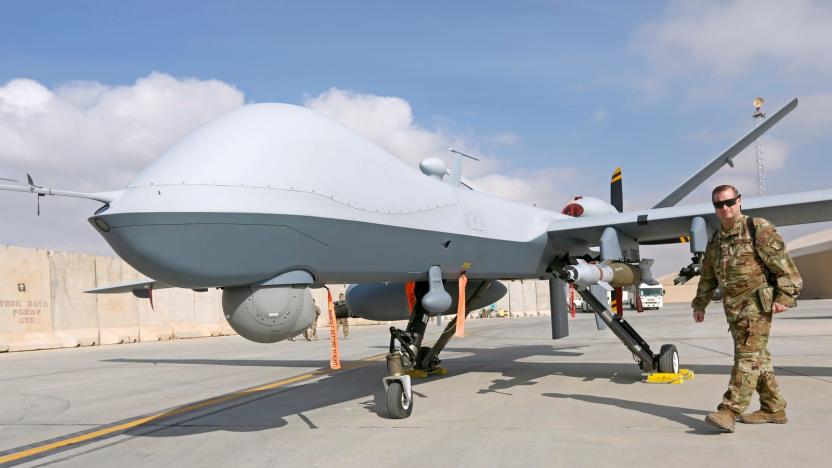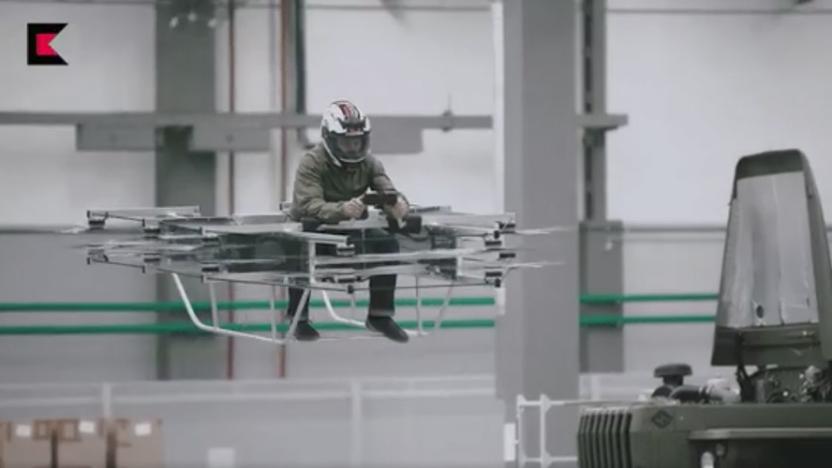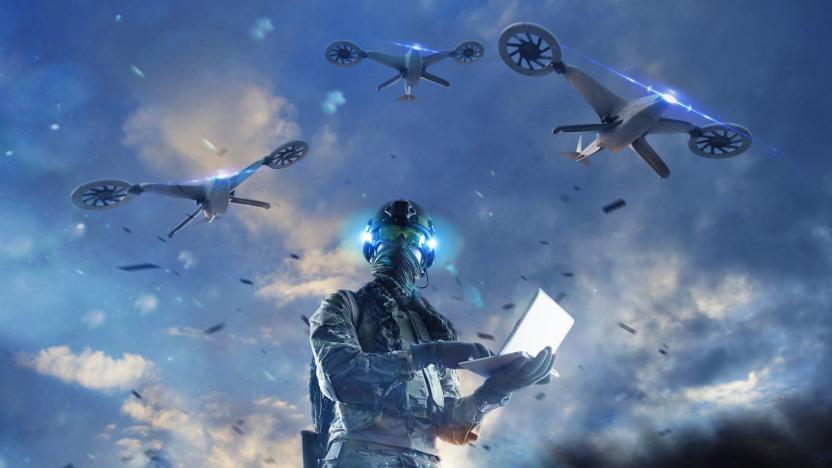UsMilitary
Latest

US military drone documents are selling for $150 on the dark web (updated)
Last month, while tracking dark web marketplaces, threat intel team Insikt Group of the security firm Recorded Future discovered that someone was selling alleged US military documents. A hacker was asking for "$150 to $200" for non-classified yet sensitive materials on the US Air Force's Reaper drone, and posted an additional bundle of information on US Army vehicles and tactics for sale.

HP Enterprise let Russia review the Pentagon's security software
Last year, Hewlett Packard Enterprise (HPE) allowed a Russian defense agency to analyze the source code of a cybersecurity software used by the Pentagon, Reuters reports. The software, a product called ArcSight, is an important piece of cyber defense for the Army, Air Force and Navy and works by alerting users to suspicious activity -- such as a high number of failed login attempts -- that might be a sign of an ongoing cyber attack. The review of the software was done by a company called Echelon for Russia's Federal Service for Technical and Export Control as HPE was seeking to sell the software in the country. While such reviews are common for outside companies looking to market these types of products in Russia, this one could have helped Russian officials find weaknesses in the software that could aid in attacks on US military cyber networks.

Kalashnikov's next military gear might be hoverbikes
Popular Mechanics reports that a Russian defense company has developed a flying vehicle that took to the air earlier this week as manufacturers demonstrated what it can do. The hovercraft, built by Kalashnikov Concern, gets its lift from 16 sets of rotors and appears to run on battery power, not fuel. It's likely that a future version of this vehicle might be used by military as Kalashnikov is already involved in the production of guns and ammunition as well as combat vehicles and automated gun systems.

Security lapse exposed thousands of military contractor files
Thousands of files containing the private info of US military and intelligence personnel have been exposed online. The documents (which included a mixture of resumes and job applications) were found on a public Amazon Web Services server by cybersecurity firm UpGuard. A research analyst for the company traced the files back to a North Carolina-based private security firm known as TigerSwan. In a statement on Saturday, TigerSwan blamed the lapse on TalentPen, a third-party recruiting vendor.

Russia is targeting US military personnel with online propaganda
Russia is going to great lengths to undermine the US military by not just spying on it, but trying to influence its members, according to a report from Politico. Operatives have been friending soldiers and veterans on social media, posting on popular sites and, of course, hacking members. The aim, according to experts, is to turn service members into a "fifth column" for Russia, and the military is struggling to stop it.

DARPA wants your gaming tactics for its drone army
Urban areas continue to vex the US military as tall buildings and narrow streets keep impeding troop communications and tactics. While ground soldiers have used single drones for years, DARPA believes that a whole swarm could mitigate those disadvantages, giving units more eyes and guns. Since the military is currently unable to control such swarms, DARPA is launching a new program to develop both drone-wrangling tech and the tactics they'd need to assist soldiers in urban environments. Oh, and they want video gamers to playtest the best strategies.

US government wants cyber forces that think like the enemy
Lawmakers want mandatory training for US military cybersecurity to act as the enemy in war games tailored to test the country's cyber defenses. The suggestion was included in a recent defense bill. To ensure attacks aren't confused with real (well, cyber) ones, agreements would be made with the Defense Secretary Ash Carter. One official described the training like the enemy squadrons used by the US Air Force during Red Flag -- a flight exercise for fighter pilots.

DARPA is developing an unjammable communications chip
Electronic warfare (EW) techniques -- from killing missiles with microwaves to downing drones with radio interference -- have become an integral part of modern wars. This issue is exasperated by the fact that both sides in a conflict must also compete for the finite spread of interference-free wireless spectrum with which they operate their multitude of wireless devices. To maintain American fighting superiority over the likes of China and Russia, both of whom are considered "near peers" in terms of EW combat capabilities, DARPA has developed an ultrafast chip to convert analog wireless signals into digital ones in record time.

DARPA's steerable bullet proves it can hit moving targets
DARPA announced that its self-steering bullet program, dubbed the Extreme Accuracy Tasked Ordnance (EXACTO), passed another developmental milestone in late February. Per an administration release, and the video below, experienced and novice shooters alike were able to strike moving targets. And, in the case of expert shooters, able to hit actively evading targets as well.

US military will spend $23 billion on cyber defense, create its own secure 4G network
The US Department of Defense told a Washington thinktank yesterday that it would spend $23 billion in the next four years to kick its cyber defenses up a gear. That'll include building out a "secure 4G wireless network that will get iPads, iPhones and Android devices online by mid-2014," according to Joint Chiefs of Staff Chairman Martin Dempsey. The DoD recently approved Blackberry 10, iOS and Samsung Galaxy devices with Knox, and General Dempsey himself was packing a smartphone he said would "make Batman and James Bond jealous." While there were no details about how such a mobile network would be locked down, he did say that all 15,000 of the Department's computer networks would be consolidated into an enterprise cloud system to increase security. All that is to combat a "17-fold" cyber warfare increase in just over two years -- no doubt including recent Chinese hacking that the White House took the rare step of recently highlighting.

DARPA threat detection technology uses a camera to see targets, software and soldier brains to identify them
DARPA aids our military in myriad ways, from designing one shot, one kill weapons to creating robotic pack mules to carry soldiers' gear. It's also been building tools for soldiers to better survey their environment and identify threats, and its latest such tool is called the Cognitive Technology Threat Warning System (CT2WS). CT2WS is comprised of a 120-megapixel electro-optical video camera with a 120-degree field of view feeding a laptop running cognitive visual processing algorithms. Those algorithms identify potential targets in the video feed, which are shown to a soldier wearing an EEG cap that monitors brain signals. You see, the human brain is particularly good at perceiving threats, and CT2WS looks for the particular brain wave that occurs when we see one. The human component drastically improves the accuracy with which the system can identify enemies from afar. How accurate? Testing in desert, tropical and open terrain showed that without a solider/EEG filter, the system had 810 false alarms out of 2,304 threat events in an hour. Incorporating the filter resulted in only five false alarms per hour, plus it was able to identify 91 percent of the potential targets successfully. Not good enough, you say? Add commercial radar into the mix and the army becomes omniscient -- the system then identified 100 percent of the test targets.

Confirmed: AT&T offers complimentary unlock of in-contract iPhones for deployed military personnel
Finally. A bit of closure. AT&T has confirmed the long-lived speculation of its policy to unlock in-contract iPhones for our military men and women deployed overseas. To qualify for the complimentary service, active military members must have an account in good standing and provide the carrier with deployment verification -- that's it, no other hoops to jump through. The revelation was made today as part AT&T's new Device Unlock Portal, which allows off-contract iPhone owners to apply online to have their handsets unlocked. Previously, this unlock service was available only through the carrier's retail outlets, online chat support or by dialing 611. As a quick rehash of the non-military policy, all users -- either current or former AT&T subscribers -- must have completed their contractual obligations to AT&T, and the phone cannot be flagged as lost or stolen. All those eligible should certainly apply for the service, as an unlocked iPhone is infinitely more useful when traveling abroad -- a reality that deployed military members know all too well. [Military photo via Shutterstock]

Military hunting smartphone safety to hold off enemy bugs, spooks
Ah, smartphones -- the delightful little slates carry our contacts, our content -- even our cash, and they still fit right in our pockets. No surprise then, that a lost or stolen phone can be a minor disaster -- or a major security risk (just ask the President). Now that soldiers are packing them to send GPS coordinates or situational images in the field -- on top of using them at home -- DARPA has enlisted security company Invincea to fortify the devices. Its first effort, encrypting OS files and filling the memory of a lost phone with worthless data, has already been deployed to 3,000 troops in Afghanistan. Its next target is to cloister apps into virtual rooms within the OS, locking off access to sensitive parts of the phone like its GPS or contact lists. That would keep any nasty bits of malware from potentially gaining root privileges so soldiers can fight, and Facebook, without compromise.

US military looking to create a 'universal remote' for drone fleets
When you've got as many different drone models as the US military, it can be hard to manage things. That's why a group inside the Pentagon is looking to help cut down on unmanned aerial fragmentation, attempting to develop a way to manage all of the different models with a universal drone controller. It's something the military has tried and failed to accomplish in the past, but this time it's taking a more smartphone-esque approach to the matter, according to Wired. The key would be to create an underlying software architecture that allows pilots to control fleets of unmanned vehicles. On top of that would be specific applications that are "down-loaded to suit individual user taste and productivity," a Pentagon official told the site. The approach would make it possible to control different models with differing functionality as a connected fleet.

Navy looks into UV cloak for stealth aircraft
The Navy's invested good money in the F-35 Joint Strike Fighter, which obscures radar waves and redirects engine heat to evade recognition by infrared sensors. But that stealth flier is still vulnerable to another type of detection: UV sensors. The Pentagon recently began soliciting proposals to develop a device that cloaks aircraft from ultra-violet detection systems. The hope is that such a technology could shield aircraft from missile seekers that scan the sky for telltale "UV silhouettes." According to the call for research, the solution could involve a device that disperses a cloud of quantum dots or other materials to veil jet fighters in a shapeless mass of UV shadow. Given that this is a rather daunting task, it's not surprising that the development timeframe and projected cost are still up in the air.

AT&T purportedly unlocks in-contract iPhones for deployed military personnel
AT&T has gotten a good amount of attention lately for unlocking off-contract iPhone handsets, but a recent report from MacRumors suggests that the carrier is extending the same privilege to members of the US military currently serving overseas. While we haven't been able to verify the report, we'd like to believe that news of AT&T's goodwill gesture is indeed genuine. Naturally, we're rather curious to know whether this policy extends to AT&T's entire range of handsets. So, if you or a loved one is on active deployment, be sure to give this a try and let us know your experience in the comments below.[Military photo via Shutterstock]

U.S. Department of Defense preps cyber rules of engagement, plans to work more closely with ISPs
The Pentagon left no room for argument last year when it declared cyber attacks a potential act of war. "If you shut down our power grid, maybe we will put a missile down one of your smokestacks," a military official reportedly remarked. Yikes. Before we start bombing chimneys, however, the Department of Defense plans to draft up some relevant guidelines, noting in a recent House Armed Services Committee hearing that it will be delivering a set of cyberspace-specific rules of engagement in the coming months. "We are working closely with the joint staff on the implementation of a transitional command and control model for cyberspace operations," said Madelyn Creedon, assistant secretary of defense for Global Strategic Affairs. In addition to setting ground rules for cyber-engagements, the DOD also plans to expand efforts to share classified information on possible threats with internet service providers and defense contractors.

Navy tests bacteria-powered hydrogen fuel cell, could start monitoring your underwater fight club
Microbial fuel cells aren't exactly new, but microbial fuel cells scouring the ocean floor? Now that's an initiative we can get behind. The Naval Research Laboratory is currently toying around with a so-called Zero Power Ballast Control off the coast of Thailand, presumably looking for treasures dropped from the speedboat of one "Alan Garner." Purportedly, the newfangled hydrogen fuel cell relies on bacteria to provide variable buoyancy, which allows an autonomous ocean sensor to move up and down water columns with little to no effort. Furthermore, it's able to get its energy from microbial metabolism (yeah, we're talking about hot air), and while it's mostly being used to measure things like temperature and pressure, it could be repurposed for more seirous tasks -- like mine detection. There's no clear word yet on when America's Navy will have access to this stuff, but if we had to guess, they've probably be using it behind our backs for the better part of a score. [Image courtesy of U.S. Navy Reserve / Tom Boyd]

Pentagon says cyber attacks are acts of war: send us a worm, get a missile in return?
Well, the Pentagon is finally fed up with hackers picking on its buddies and foreign intelligence taking shots at its computer systems, and has decided that such cyber attacks can constitute an act of war. Of course, the powers that be won't be bombing you for simply sending them some spyware, but attempts to sabotage US infrastructure (power grids, public transit, and the like) may be met with heavy artillery. It's unclear how our government will identify the origin of an attack or decide when it's serious enough to start shooting, but Uncle Sam is looking to its allies to help create a consensus answer for those questions. The retaliatory revelation is a part of the Pentagon's new cyber strategy that'll be made public in June -- so saboteurs beware, your next internet incursion might get you an ICBM in your backyard.

Marines field test solar panels by day, watch Gomer Pyle by night
United States Marines are among the best-equipped soldiers on the planet, but more gadgets mean extra batteries to haul, adding dozens of pounds on extended missions. Troops in Afghanistan recently put that hot Middle Eastern sun to use, swapping spare batteries for placemat-size solar panels on a three-week patrol. Batts were replaced with extra bullets, so the soldiers didn't get off easy, but they were also able to reduce generator usage, making a significant dent in fuel consumption. It will be several years before all soldiers charge their radios, night vision goggles, and GPS devices using the sun, but the Marine Corps hopes to cut fuel use in half by 2025, so it's only a matter of time before solar-powered gadgets have a more permanent home on the battlefield. Sha-zam!












